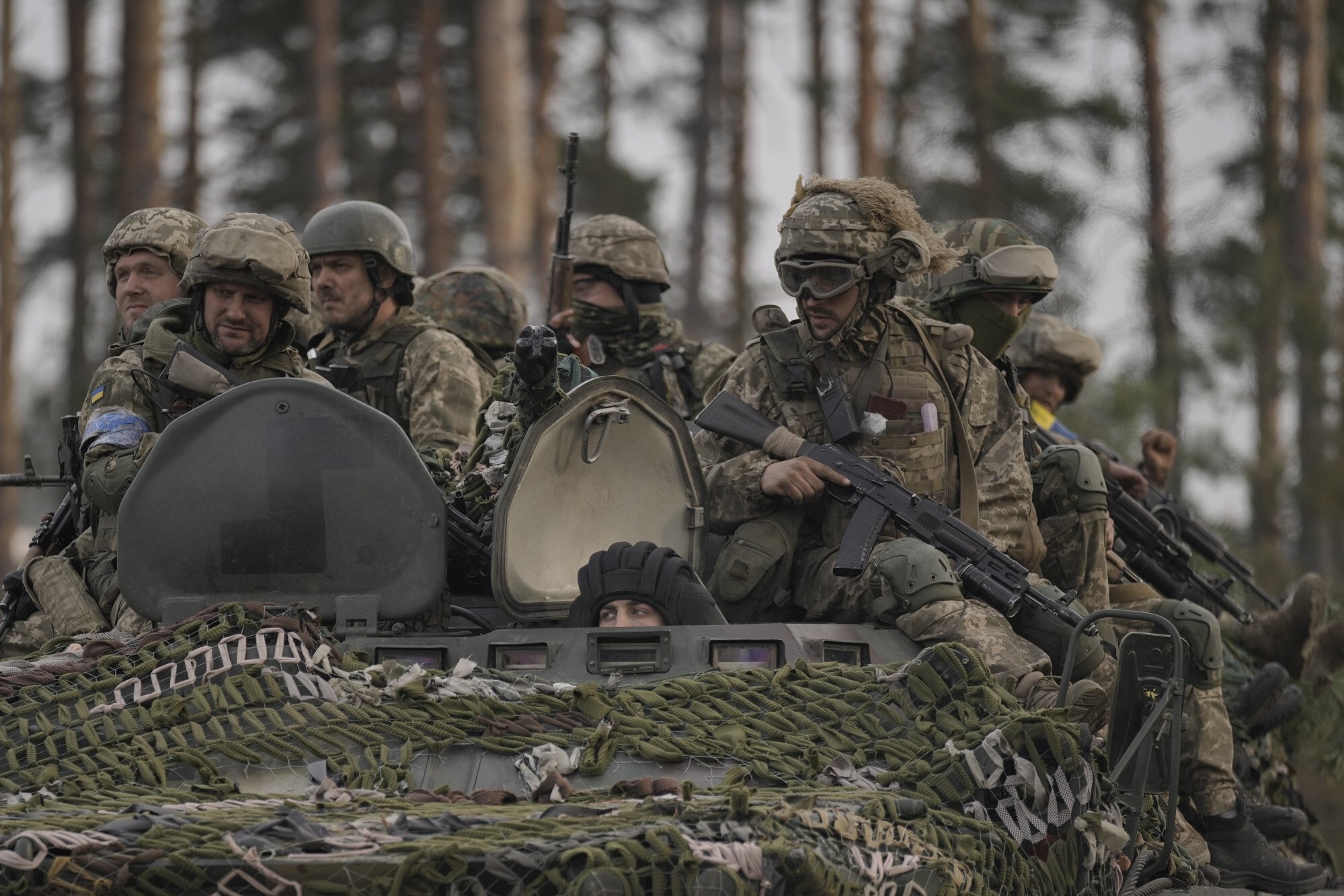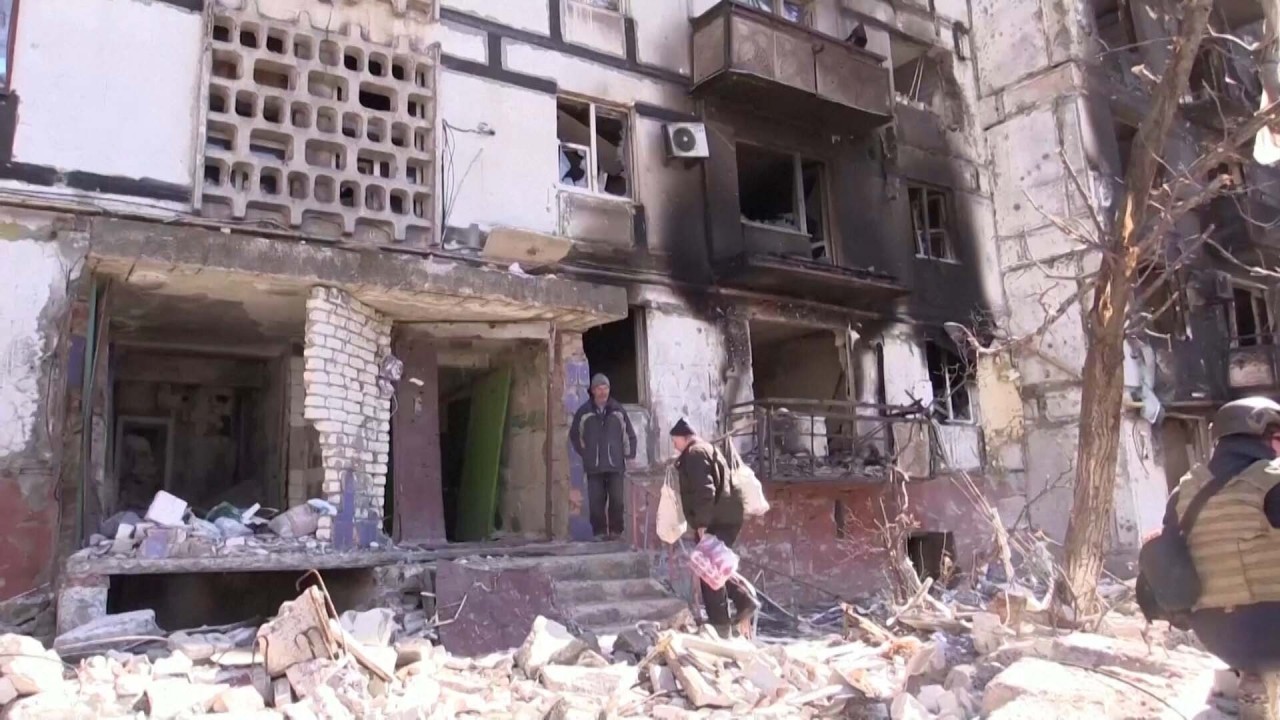
Ukraine war: Thousands flee Mariupol as Red Cross prepares fresh rescue effort after weeks of Russian shelling
- 3,000 people escaped the besieged area of Mariupol as the Red Cross prepared a fresh evacuation effort for the devastated southern port
- Meanwhile, peace talks between Kyiv and Moscow resumed via video, but the Kremlin warned a Ukrainian attack on a Russian fuel depot would hamper negotiations
More than 3,000 people have escaped the besieged region of Mariupol in a convoy of buses and private cars, Ukrainian President Volodymyr Zelensky said Saturday as the Red Cross prepared a fresh evacuation effort for the devastated southern port.
The city has faced weeks of ferocious Russian shelling, with at least 5,000 residents killed, according to local authorities, and the estimated 160,000 who remain face shortages of food, water and electricity.
“We have managed to rescue 6,266 people, including 3,071 people from Mariupol,” Zelensky said in a video address early Saturday.
Giving details of Friday’s evacuation efforts along humanitarian corridors, Deputy Prime Minister Iryna Vereshchuk said 42 buses carrying Mariupol residents had departed from the city of Berdiansk, 70 kilometres southwest, while another 12 had left Melitopol with local residents on board.

“That’s more than 2,500 people. More than 300 private cars follow the buses. All of them are now heading to the city of Zaporizhzhia,” she said on Telegram, adding more evacuations of Mariupol were planned for Saturday.
Dozens of buses carrying Mariupol residents who had escaped the devastated city arrived Friday in Zaporizhzhia, about 200 kilometres to the northwest, according to an AFP reporter on the scene.
The buses carried people who had been able to flee Mariupol to Russian-occupied Berdiansk.
“We were crying when we reached this area. We were crying when we saw soldiers at the checkpoint with Ukrainian crests on their arms,” said Olena, who carried her young daughter in her arms.
“My house was destroyed. I saw it in photos. Our city doesn’t exist any more.”
The International Committee of the Red Cross said its team headed to Mariupol to conduct an evacuation effort was forced to turn back Friday after “arrangements and conditions made it impossible to proceed”. It said it would try again Saturday.
Peace talks between Kyiv and Moscow resumed via video, but the Kremlin warned that what it described as a helicopter attack on a fuel depot would hamper negotiations.
“This is not something that can be perceived as creating comfortable conditions for the continuation of negotiations,” Kremlin spokesman Dmitry Peskov told reporters.
The air strike hit energy giant Rosneft’s fuel storage facility in Belgorod, around 40 kilometres from the border with Ukraine.
But Kyiv would not be drawn on whether it was behind the attack, with Zelensky telling US network Fox News: “I’m sorry, I do not discuss any of my orders as commander in chief”.
Britain’s defence ministry said the destruction of oil tanks in Belgorod and reports of explosions at an ammunition depot near the city would add to Russia’s resupply problems.
“The probable loss of fuel and ammunition supplies from these depots will likely add additional short-term strain to Russia’s already stretched logistic chains,” it said in its latest intelligence update on Twitter late Friday.
After five weeks of a military campaign that has reduced parts of Ukraine to rubble, Moscow said this week it would scale back attacks on the capital Kyiv and the city of Chernigov.
But Zelensky said Russia was consolidating and preparing “powerful strikes” in the east and south, joining Western assessments that Moscow’s troops were regrouping, not withdrawing.
Zelensky repeated his plea for the West to provide greater military support.
“Just give us missiles. Give us aeroplanes,” he said on Fox. “You cannot give us F-18 or F-19 or whatever you have? Give us the old Soviet planes. That’s all … Give me something to defend my country with.”
The Pentagon later said it was allotting US$300 million in “security assistance” to bolster Ukraine’s defence capabilities, adding to the US$1.6 billion Washington has committed since Russia invaded in late February.
The announcement comes after President Joe Biden and Zelensky on Wednesday discussed “additional capabilities” to help the Ukrainian military.
The package includes laser-guided rocket systems, drones, ammunition, night-vision devices, tactical secure communications systems, medical supplies and spare parts.
Russia launched its invasion on February 24, expecting to quickly take Kyiv.
A ferocious Ukrainian fightback and Russia’s logistics and tactical problems scuppered such plans.

On the ground, Ukraine’s troops were beginning to reassert control including around Kyiv and in the southern region of Kherson – the only significant city that Russia had managed to occupy.
Ukraine’s defence ministry said Russian troops were continuing their “partial retreat” from the north of Kyiv towards the Belarusian border.
Ukraine also warned that Russian forces who left the Chernobyl nuclear plant – site of the world’s worst nuclear accident, in 1986 – after weeks of occupation may have been exposed to radiation.
“Russia behaved irresponsibly in Chernobyl” by digging trenches in contaminated areas and keeping plant personnel from performing their duties, said Foreign Minister Dmytro Kuleba.
Civilians have trickled out of devastated areas after arduous and daring escapes.
Three-year-old Karolina Tkachenko and her family walked an hour through a field strewn with burnt-out Russian armoured vehicles to flee their village outside Kyiv.
“The shops are closed, there’s no delivery of supplies. The bridge is also blown up, we can’t go for groceries through there,” said Karolina’s mother Karina Tkachenko.

In Mariupol, Viktoria Dubovytskaya, who had sheltered in the theatre where 300 people are feared to have been killed in Russian bombardments, said she only grasped the extent of the destruction as she fled.
Bodies lay in the rubble and small wooden crosses were planted in the ground, she told AFP.
“When people find their loved ones, they just bury them wherever they can. Sometimes where roses used to bloom,” she said. “The city is now a common grave.”

.png?itok=arIb17P0)
